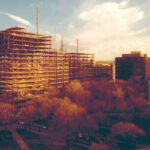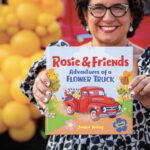
Photo courtesy of Angela den Hoed
For years, Harrisburg-area resident Cynthia Hogeman has led a group in a monthly bike ride on the Capital Area Greenbelt. In the spring, that has often included spotting the newly bloomed daffodils, hundreds of which she planted herself, in Harrisburg.
Hogeman has gardened since she was young and, once she retired, studied to become a master gardener through Penn State Extension’s program. Naturally, she loves plants.
But she started to notice, during the group’s bike rides, that the flowers were blooming earlier and earlier each year. She had once considered hosting a special spring ride just to see the daffodils, but realized their arrival had become too inconsistent for scheduling.
“I remember when we would do the ride right around tax day and see them,” she said. “But it gradually got earlier and earlier.”
It wasn’t just the daffodils that she took notice of, but the many plants that were budding out and blooming earlier as the warmer spring weather seemed to arrive sooner each season.
“If you’ve been a gardener for the long haul, you’ve seen the changes,” she said. In November 2023, new information released by the U.S. Department of Agriculture (USDA) appeared to confirm what Hogeman and many other gardeners were already seeing. In central Pa.—like in much of the nation—temperatures were warming.
Eleven years after its previous edition, the agency updated its Plant Hardiness Zone Map, a tool that gardeners use to determine which plants will thrive in their region, based on the average annual lowest temperatures.
That update showed that about half of the country shifted up to the next-warmer half zone. Much of central Pa. moved from zone 6b to 7a, meaning that the average annual extreme minimum temperature moved from a range of -5 to 0 degrees to 0 to 5 degrees.
When the new map was released, the USDA specifically cautioned the public from attributing the warming to global climate change. They cited the highly unpredictable nature of annual extreme minimum temperatures and the use of increasingly detailed and specific mapping methods as possible reasons for the zone changes. The map, which relies on 30-year averages, pulled from data recorded at 13,412 weather stations. The 2012 map only used information from 7,983 stations.
However, PennFuture, a Harrisburg-based nonprofit environmental advocacy group, linked the changes directly to global warming. In a December editorial response to the map update, they stated that it was “a stark, full-color depiction of the progress of climate change.”
While many local gardeners and growers aren’t necessarily expecting to see big immediate changes in terms of which plants will or will not thrive in central Pa. with the zone shift, most have their concerns about the long-term effects of warming temperatures.
Angela den Hoed, owner of Carlisle-based landscape design company Soil + Ink, said that her clients are starting to notice small, incremental changes in the weather too and are wondering what it means for their home gardens.
“My clients ask me all the time what to expect,” she said. “I say, expect it to be unpredictable.”
Adaptability Possibility
Ember Jandebeur, of Susquehanna Township, is a self-proclaimed “plant nut.” The Dauphin County master gardener and former environmental lawyer, maintains a garden at her own home, while also volunteering at Wildwood Park, the state Capitol’s Hunger Garden and the Harrisburg Cemetery, among other places.
She has used the zone map to determine which plants would work best for her region and expects that, with the map update, there may be some that previously didn’t grow well that will do better and others that thrived that will begin to struggle.
The spider lily is one type of flower that Jandebeur said she may “take a chance” on now. The flower typically does best in zones 6 to 10, previously a stretch for growing in Harrisburg, according to the 2012 map, but now may be more reasonable based on the 2023 update.
For the most part, Jandebeur sticks to native plants, which she believes will generally fare well even with the changing weather. While the definition of “natives” can be different to different gardeners, depending on how broad or specific of a location they look at, Jandebeur plants anything native to North America. Because many natives are already accustomed to the local temperatures, a few degrees difference likely won’t make a significant impact on the plant, she said.
However, she predicts that the warmer temperatures will fuel the spread of invasive species, those that are not native to this climate.
According to the North American Invasive Species Management Association, invasive plants are shifting north and taking advantage of the earlier spring warmth by sprouting before the natives do, monopolizing soil space and sunlight.
Invasive insects are also becoming an increasing threat as the warmer weather allows them to live longer, Jandebeur said.
For as much as she loves plants, Jandebeur loves birds just as much, especially hummingbirds, or “hummers” as she lovingly calls them. A lot of what she plants, such as salvia flowers, is catered towards attracting pollinators—birds and insects.
“I’m trying to make a bird way station in the middle of Harrisburg,” she said.
However, she’s worried that the hummingbirds will not adjust to the unusual blooming times and therefore not get the nutrients they need. According to Jandebeur, only a very small percentage of hummingbirds and songbirds survive to their second year, and without adequate nectar, that could lower their chances of survival even more.
“They may get caught up without blooms to feed up on before migration,” she said. “Climate change will play havoc, and we don’t know if they will be able to adapt or not.”
So Unpredictable
Ultimately, it seems that the new plant hardiness zone map won’t have a huge immediate impact on plant supply, although growers and landscapers are seeing incremental changes, too.
Local growers and plant centers likely won’t be quick to add or remove plants from their greenhouses. Bryan Benner, the head perennial grower at Quality Greenhouses, a wholesale grower in Dillsburg, said that, because of the highly variable nature of the weather, his work won’t change much due to the new zone map.
“You can still have some nights that are colder than what the zone says,” Benner said.
He also said that the company already grows some plants that are in zone 7, as the greenhouse distributes outside of the state, as far as southern Virginia.
However, if it keeps getting warmer, he does foresee certain cold weather plants dying off. That has already started to happen with plants like the sugar maple tree, he said. But those shifts “don’t happen fast,” he added.
If the map changes anything for Quality Greenhouses, it may be that an earlier spring brings customers to the greenhouse sooner, which would be good for business, he said. But, that doesn’t negate his concern about climate change, he stated.
Business will likely remain strong for Harrisburg-area native plant landscaping company, Green Gardner, as well. Owners Jes and Ian Gardner work with residential and commercial clients to plant species that are beneficial to the local ecosystems. As a result of milder winters, last year, they were able to work with clients almost year round, they explained.
Intentionally utilizing native plants—the Gardners use ones specific to the U.S., often native to the county or region—can actually help ecosystems navigate climate change. Like Jandebeur said, the Gardners explained that the updated zone map doesn’t really affect natives, since they are already well adapted to the local environment. Natives also help make the air and water cleaner, they said.
“The fact that we need hardiness zones is because we are planting non-natives that are killing our environment,” Ian said. “If we are able to support nature, we can limit the impacts of climate change.”
Ian did, however, say that he’s concerned about the weather becoming too warm for certain types of native birch trees.
But maybe even more harmful than the slightly warmer temperatures is the inconsistent and extreme weather—for example, going from a period of drought to heavy rain and flooding, the Gardners said.
Like den Hoed of Soil + Ink said, expect the unexpected.
When helping clients with landscape design, den Hoed said that she works to build in resilience. She recommends some plants that will survive drought better and some that can withstand flooding, among others. That diversity can help a garden survive.
She’s also making sure that, when clients choose plants with long lifespans, like trees, they select species that can weather the warmer temperatures in the coming years.
“It’s just so unpredictable,” she said.
To learn more about Soil + Ink, visit www.soilandink.co.
For more information on Green Gardners, visit www.greengardnerdesigns.com.
Quality Greenhouses is located at 250 Union Church Rd., Dillsburg. For more information, visit www.qualitygreenhouses.net.
To learn more about the Penn State Extension’s Master Gardeners of Dauphin County, visit www.extension.psu.edu/programs/master-gardener/counties/dauphin or call their hotline at 717-921-8803 to speak with a master gardener.
If you like what we do, please support our work. Become a Friend of TheBurg!





